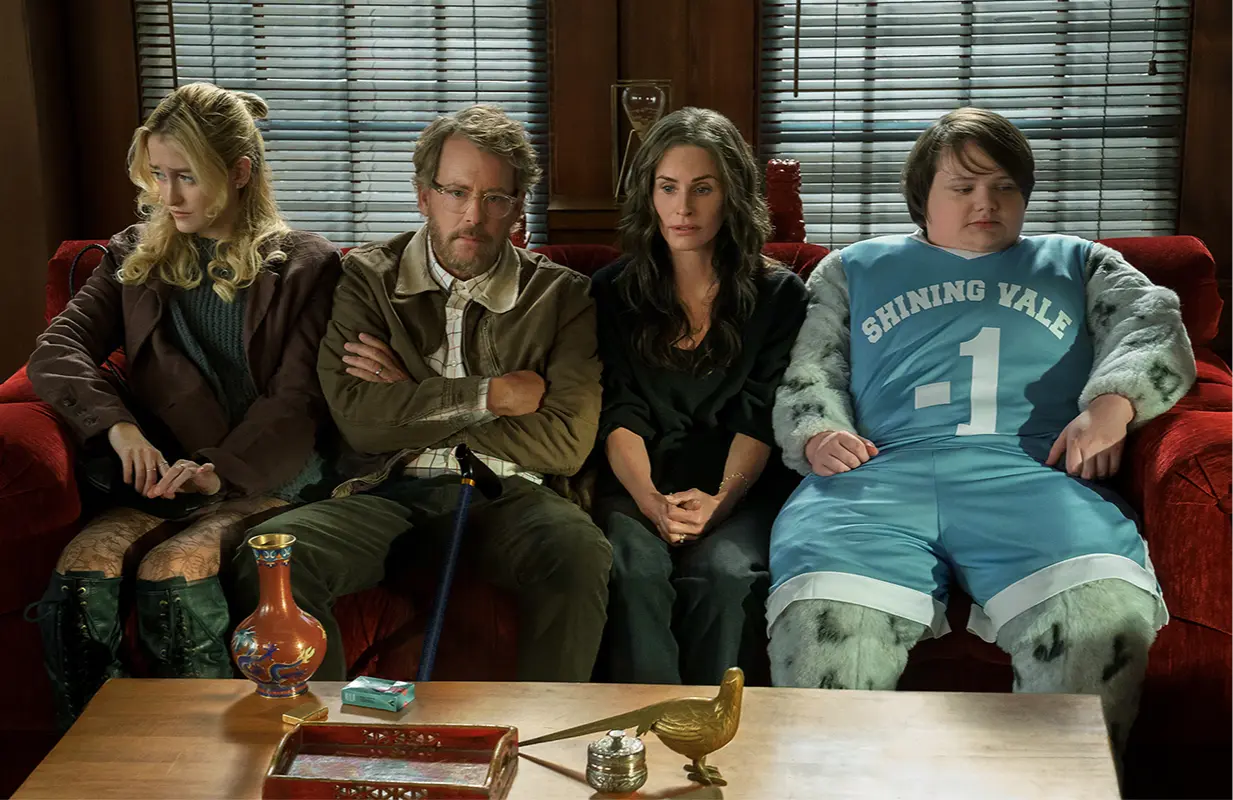Women's Body Horror Makes the Return Trip to Shining Vale Worth It
-
 Gus Birney, Greg Kinnear, Courteney Cox, and Dylan Gage star in Shining Vale (Photo: Starz)
Gus Birney, Greg Kinnear, Courteney Cox, and Dylan Gage star in Shining Vale (Photo: Starz)Horror-comedy Shining Vale stumbles in its sophomore season, unsure how to consistently advance its plot while keeping the focus on what made its first season work: a modern take on female body horror.
The problems begin in the first episode, which is tasked with addressing the Season 1 cliffhanger and setting up the plot for Season 2. That’s a lot, and although it’s just 32 minutes, the premiere feels bloated, more a set of checked boxes than a compelling narrative. Things improve, even though Pat Phelps (Courtney Cox) is saddled with a bizarre costume after being released from the institution: her grey-streaked wig and oddly-colored contacts are just distracting. We don’t need Pat to look so odd to understand her mental and psychological changes.
Thankfully, Pat transforms back into the character we know and root for around the time the show really gets going. The middle act of Season 2 really works, dramatizing historical treatments for women’s mental health (although the myth of doctors using vibrators on women in mental institutions has been debunked) and contrasting that with the culture Pat lives in today, where she wants to achieve professional success, take care of all the housework, and have a fulfilling sex life.
Here, Shining Vale returns to its commentary about “hysterical” women — when they can be believed (almost never) and when they can’t (when it suits anyone else’s interest). Pat is bombarded with messages that she can’t trust her own instincts; she did try to murder her husband with an ax, after all. But without her gut, she’s left with nothing to follow but society’s script of what a good mother should be. So, she drinks the tea society serves her. She sets about cleaning the house. She tries to be nurturing to her kids and sexually available to her husband. They are not particularly receptive.
Part of the problem is that she’s lost their trust — she failed at the main thing moms are supposed to do. When she was in the hospital, her family, particularly daughter Gaynor (Gus Birney, having fun in the righteously angry and sexually frustrated role) adapted to her absence. But no one in Pat’s family — Gaynor, husband Terry (Greg Kinnear), and the oft-overlooked Jake (Dylan Gage) — ever appears to have really seen her as she is. She was more of an appliance to them than a person, a set of domestic duties suddenly left undone and nothing more. And now she’s an appliance that can’t even be trusted to regularly be in its place.
Now obviously, Pat is not alone in that situation — women’s rage is always simmering, waiting to be ignited. And the show does let it boil over at times, revealing just how frustrating it can be to perform femininity. As the season goes on, things don’t get easier for Pat in her present-day or her flashbacks/nightmares, especially not once the show throws itself fully into an homage to one of the first female body horror films. In this third act, Cox gets another terrible look, and it’s as if Shining Vale creators Jeff Astrof and Sharon Horgan don’t trust their audience to follow even the most basic of cues. We can understand that the plot is shifting without needing the protagonist to look wildly different.
But that’s Shining Vale — it’s not trying to be subtle, nor should it. There’s a long history of going over the top in its horror-comedy genre. But rather than being funny or scary, gags about Jake’s social awkwardness and Cox’s appearance in her terrible bookending costumes are just bothersome. Lines like “she looks like the Joker” or comments on Pat’s terrible haircut later on don’t add to the show’s feminist underpinnings or say anything novel; women being judged for their appearance is neither funny nor new. Rather, these moments just draw further attention to the show’s weaknesses: its inability to trust and respect its audience.
Still, Shining Vale succeeds when it leans into the peculiar ridiculousness of being a woman today, whether that’s the cult around youth and fertility, the history and present state of women’s mental health care, or the incompatibility of the creative mind inside the mother’s body. The result is an uneven series that is at its best when letting its cast shine and leveraging its modern sensibility to reframe old stories and tell new ones. When it’s distracted by its references and convoluted story, it doesn’t work nearly so well.
Which is a shame because Shining Vale’s premise, cast, and cultural insights are all compelling. Certainly, the moment for feminine body horror is now, as women’s real-life rights and political power sink in a current of conservative insistence on traditional gender norms. And Shining Vale is particularly primed for success because it knows how to find the humor in women’s frustrating place in society, most often by punching up. Still, it can’t resist punching down occasionally and when it does, it betrays itself, its strengths, and its audience.
Shining Vale Season 2 premieres October 13 on Starz. Join the discussion about the show in our forums.
A writer and activist, Cristina Escobar is the co-founder of LatinaMedia.Co, uplifting Latina and gender non-conforming Latinx perspectives in media. She writes at the intersection of race, gender, and pop culture.
TOPICS: Shining Vale, Starz, Courteney Cox, Greg Kinnear, Gus Birney, Jeff Astrof, Sharon Horgan